

Nineteenth century
Some
were Oxbridge graduates (as had been all the Floating Church and
Sailors' Asylum clergy), but a good number were from Trinity College
Dublin (TCD) - despite Bishop Blomfield's prejudice against them - see
the note here on ordination training. And like the Vicar Dan Greatorex
some came from St Bees in Cumbria; and others from King's College
London (KCL). Many served overseas, before or after their time here.
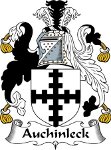 Alexander Eccles Auchinleck (1855):
son of a clergyman and JP with two homes in County Fermanagh (Castle
Lodge and Mullans) - with other clerical relatives in the area - though
the family's roots were at Auchinleck in Ayrshire, Scotland, with a
barony from the early 16th century acquired from James IV: James
Boswell, the diarist associated with Samuel Johnson, was the 9th Laird.
The Gaelic Ach-ea-leac means 'the field of the flat stone', as the area
abounds in flat sheliving rock. The family arms are described as argent, a cross counter embattled sable. Alexander
studied at TCD
(and was awarded a 'catechetical premium' in 1841); ordained in Lincoln
diocese,
he served curacies there, in Southampton and at Walwith (= Walworth,
Northumberland?) before his brief time here; he then became curate of
Playden, near Rye (returning to St Peter Dublin in 1862 to marry Fanny
Crozier), and then of Dronfield in Derbyshire, at that time in
Lichfield diocese (returning to St Stephen Dublin in 1871 to marry
Sydney Spear, his second wife). Here he took a keen interest in the
legal arrangements for the
emerging American Episcopal Church. In 1879 he became
Vicar of Car Colston in Nottinghamshire, where he remained
until his death in 1904.
Alexander Eccles Auchinleck (1855):
son of a clergyman and JP with two homes in County Fermanagh (Castle
Lodge and Mullans) - with other clerical relatives in the area - though
the family's roots were at Auchinleck in Ayrshire, Scotland, with a
barony from the early 16th century acquired from James IV: James
Boswell, the diarist associated with Samuel Johnson, was the 9th Laird.
The Gaelic Ach-ea-leac means 'the field of the flat stone', as the area
abounds in flat sheliving rock. The family arms are described as argent, a cross counter embattled sable. Alexander
studied at TCD
(and was awarded a 'catechetical premium' in 1841); ordained in Lincoln
diocese,
he served curacies there, in Southampton and at Walwith (= Walworth,
Northumberland?) before his brief time here; he then became curate of
Playden, near Rye (returning to St Peter Dublin in 1862 to marry Fanny
Crozier), and then of Dronfield in Derbyshire, at that time in
Lichfield diocese (returning to St Stephen Dublin in 1871 to marry
Sydney Spear, his second wife). Here he took a keen interest in the
legal arrangements for the
emerging American Episcopal Church. In 1879 he became
Vicar of Car Colston in Nottinghamshire, where he remained
until his death in 1904. 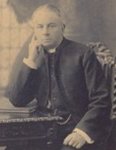 Edward James Talbot Laughlin (1858): another TCD man, born 1830, who after graduating in 1851 joined the 2nd West India Regiment
as an Ensign, becoming a Lieutenant in 1854. Raised in 1795 as Myers
Regiment of Foot, this was one of twelve (later reduced to six) units
recruiting free-born blacks and (until abolition) slaves in the West
Indies; though always fully part of the British Army, they were not a
popular choice for officers - which is perhaps why his commission was
'without purchase'. (Here
is a later picture of what may possibly have resembled its uniform.) He
saw action in the West Indies and the west coast of Africa, and then
(with the 41st Royal Welch Regiment) in the Crimea (did his paths cross
with those of George Mockler who had been a curate at Christ Church Watney Street, or Alfred Cay, later at St George's?) He was then ordained, taking an ad eundem or
courtesy MA degree from Oxford in 1857 (a practice that continued with
Oxford, Cambridge and Dublin, and some colonial universities, after it had ceased elsewhere) and served
here briefly; he married in 1860. He was curate of West Bilney in
Norfolk from 1862, and from 1866 until his death in 1886 of Willingham,
in Ely diocese, living in the Rectory; he died intestate, and was
buried in the churchyard there. His daughter Susannah became a Roman
Catholic, and one of her children became a nun.
Edward James Talbot Laughlin (1858): another TCD man, born 1830, who after graduating in 1851 joined the 2nd West India Regiment
as an Ensign, becoming a Lieutenant in 1854. Raised in 1795 as Myers
Regiment of Foot, this was one of twelve (later reduced to six) units
recruiting free-born blacks and (until abolition) slaves in the West
Indies; though always fully part of the British Army, they were not a
popular choice for officers - which is perhaps why his commission was
'without purchase'. (Here
is a later picture of what may possibly have resembled its uniform.) He
saw action in the West Indies and the west coast of Africa, and then
(with the 41st Royal Welch Regiment) in the Crimea (did his paths cross
with those of George Mockler who had been a curate at Christ Church Watney Street, or Alfred Cay, later at St George's?) He was then ordained, taking an ad eundem or
courtesy MA degree from Oxford in 1857 (a practice that continued with
Oxford, Cambridge and Dublin, and some colonial universities, after it had ceased elsewhere) and served
here briefly; he married in 1860. He was curate of West Bilney in
Norfolk from 1862, and from 1866 until his death in 1886 of Willingham,
in Ely diocese, living in the Rectory; he died intestate, and was
buried in the churchyard there. His daughter Susannah became a Roman
Catholic, and one of her children became a nun. Robert Henry Vickers (1860),
also graduated from TCD, in 1855, and was ordained that year by the
Bishop of London to serve as a CMS missionary in India, setting sail
with his wife
from East India Docks; he was based in Travancore, from where he sent
letters on the Indian Mutiny and other papers. He returned in 1859. In
1869 (when he was
living in Kilburn) he produced a verse translation of La Nobla Leyczon, a late 12th century text in Old Occitan which is the foundation document of the early Protestant Waldensian
movement. He died in 1871, and his widow returned to Madras; his son
Wildred Constant Vickers was a Surgeon-Major in the Indian Medical
Service.
Robert Henry Vickers (1860),
also graduated from TCD, in 1855, and was ordained that year by the
Bishop of London to serve as a CMS missionary in India, setting sail
with his wife
from East India Docks; he was based in Travancore, from where he sent
letters on the Indian Mutiny and other papers. He returned in 1859. In
1869 (when he was
living in Kilburn) he produced a verse translation of La Nobla Leyczon, a late 12th century text in Old Occitan which is the foundation document of the early Protestant Waldensian
movement. He died in 1871, and his widow returned to Madras; his son
Wildred Constant Vickers was a Surgeon-Major in the Indian Medical
Service. William Brown Keer (1861-65):
son of a devout Methodist farmer in Suffolk (of whom he wrote a memoir in the 1868 Wesleyan-Methodist Magazine),
he trained at St Bees. As a curate in Liverpool he was
attacked and beaten by a Catholic mob in June 1858 and was protected
the following week by Protestant bodyguards (compare the riots at St
George-in-the-East the following year!) He came here after a further
curacy in Bradford. At Christ Church, Watney Street he preached a
sermon Baptism, Regeneration & Discipleship in response to Spurgeon's
attacks on Anglican baptismal teachings, and also Numbering our days; or, thoughts for the old and new year (both published by William Macintosh 1864). He was
then approved for missionary service
by the Society for the Propagation of the Gospel - as was a successor-curate Francis
Jephcott in the same year - and
for 7 years took up new work as chaplain in Bombay, living on a
warship in the harbour (shades of the Episcopal Floating Chapel that
preceded St
Paul's): see these notes of a mission tour in Ceylon and South India, and in Kattywar and Cutch, and also various published talks there, including Navigation Ancient & Modern (1866), Paris, Past and Present, a lecture at Bombay Town Hall for the Mechanics' Institution (Education Society's Press 1867) and Books and Reading as a Recreation (Bombay Gazette Steam Press 1871).
William Brown Keer (1861-65):
son of a devout Methodist farmer in Suffolk (of whom he wrote a memoir in the 1868 Wesleyan-Methodist Magazine),
he trained at St Bees. As a curate in Liverpool he was
attacked and beaten by a Catholic mob in June 1858 and was protected
the following week by Protestant bodyguards (compare the riots at St
George-in-the-East the following year!) He came here after a further
curacy in Bradford. At Christ Church, Watney Street he preached a
sermon Baptism, Regeneration & Discipleship in response to Spurgeon's
attacks on Anglican baptismal teachings, and also Numbering our days; or, thoughts for the old and new year (both published by William Macintosh 1864). He was
then approved for missionary service
by the Society for the Propagation of the Gospel - as was a successor-curate Francis
Jephcott in the same year - and
for 7 years took up new work as chaplain in Bombay, living on a
warship in the harbour (shades of the Episcopal Floating Chapel that
preceded St
Paul's): see these notes of a mission tour in Ceylon and South India, and in Kattywar and Cutch, and also various published talks there, including Navigation Ancient & Modern (1866), Paris, Past and Present, a lecture at Bombay Town Hall for the Mechanics' Institution (Education Society's Press 1867) and Books and Reading as a Recreation (Bombay Gazette Steam Press 1871). | A
Career of Adventure Recently passed away a remarkable man in the person of the Rev. William Brown Keer, who had the courage to ride alone across Asia from the Persian Gulf to the Mediterranean in order to visit the ruins of Nineveh and Babylon. He did some hard work at Liverpool and In the East End of London before he went to India for seven years' work as harbour chaplain at Bombay, and as chaplain at Chili [sic], for which place he started from Oxford at a few hours' notice. In 1892 he sailed in a native ship to the Persian Gulf, bought a horse, and started on a perilous ride to Nineveh and Babylon. When he encountered robbers, who must have known that he had a considerable amount of money about him, he repeated very impressively the texts from the Koran as to hospitality to strangers and was never molested. He was a frequent contributor to magazines, and his death is said to be due to his never eating anything after his tea at 6 o'clock, and going out three years ago to an early service on All Saints Day without food, when he was seized with a stroke of paralysis from which he only partially recovered. |
 George Tripp (1862-68)
was born in 1837 and grew up at Altarnun in Cornwall (the 'cathedral of
the
moors'), where in 1842 his father Robert Henry Tripp (1801-80), vicar there for many years, built
the parsonage house (now Penhallow Manor - right) which is said to be the
inspiration for the sinister albino Francis Davey's rectory in Daphne du Maurier's Jamaica Inn
- and
is also said to be haunted by the ghosts of Mary the housekeeper and
the vicar with whom she had an affair. He trained at KCL and
served his title here (staying longer than most, and living in
Taymouth Terrace, Philpot Street),
going on to curacies at Lambeth, Bethnal Green, Cheshunt, St Peter Regent Square
and Chelsea. By 1881 was
a curate in Sutton, Lancs, lodging in New Street with the Rosbotham
family (daughter Hannah,
a schoolteacher, was the first female recipient of the Albert Medal for
her part in rescuing children from the school after violent storm
damage), and in 1886 was living in Thornton, near Leicester (and a
member of the Anti-Vivisection Society). He died in 1896, of chill and pneumonia, in Market Bosworth workhouse (having been a curate in the parish), said to have given away £20,000 over the years to any who
asked him for help, including foreign missions.
George Tripp (1862-68)
was born in 1837 and grew up at Altarnun in Cornwall (the 'cathedral of
the
moors'), where in 1842 his father Robert Henry Tripp (1801-80), vicar there for many years, built
the parsonage house (now Penhallow Manor - right) which is said to be the
inspiration for the sinister albino Francis Davey's rectory in Daphne du Maurier's Jamaica Inn
- and
is also said to be haunted by the ghosts of Mary the housekeeper and
the vicar with whom she had an affair. He trained at KCL and
served his title here (staying longer than most, and living in
Taymouth Terrace, Philpot Street),
going on to curacies at Lambeth, Bethnal Green, Cheshunt, St Peter Regent Square
and Chelsea. By 1881 was
a curate in Sutton, Lancs, lodging in New Street with the Rosbotham
family (daughter Hannah,
a schoolteacher, was the first female recipient of the Albert Medal for
her part in rescuing children from the school after violent storm
damage), and in 1886 was living in Thornton, near Leicester (and a
member of the Anti-Vivisection Society). He died in 1896, of chill and pneumonia, in Market Bosworth workhouse (having been a curate in the parish), said to have given away £20,000 over the years to any who
asked him for help, including foreign missions.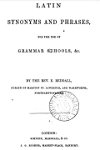 Enoch Reddall (1869-70)
had a complex life, which it's hard to piece together, with a sad
ending. Born in Birmingham in 1816 (baptized at St Philip's, but not
until he was 8 or 9 - why?), he married Mary in 1842 at St Margaret
Westminster (so had one of them 'society' connections?) and ordained
the same year as a 'literate' [non-graduate], he spent his time seeking
to provide for their eight sons and two daughters, in a variety of
curacies, schoolmaster posts and workhouse chaplaincies. His title was
at Morley, near Leeds (in Ripon diocese) but the next year they moved
to Northamptonshire (Peterborough diocese) - possibly after a failed
curacy at Bunbury in Cheshire - where he became curate at Marston
St Lawrence & Warkworth (near Brackley). He preached a sermon at
Banbury in 1843 in aid of the national schools, at which the impressice
sum of £11 7s. 10d. was collected. From here in 1844 he published
Latin Synonyms
and Phrases for the use of Grammar Schools &c - very good as far as it goes said The Literary Gazette.
Enoch Reddall (1869-70)
had a complex life, which it's hard to piece together, with a sad
ending. Born in Birmingham in 1816 (baptized at St Philip's, but not
until he was 8 or 9 - why?), he married Mary in 1842 at St Margaret
Westminster (so had one of them 'society' connections?) and ordained
the same year as a 'literate' [non-graduate], he spent his time seeking
to provide for their eight sons and two daughters, in a variety of
curacies, schoolmaster posts and workhouse chaplaincies. His title was
at Morley, near Leeds (in Ripon diocese) but the next year they moved
to Northamptonshire (Peterborough diocese) - possibly after a failed
curacy at Bunbury in Cheshire - where he became curate at Marston
St Lawrence & Warkworth (near Brackley). He preached a sermon at
Banbury in 1843 in aid of the national schools, at which the impressice
sum of £11 7s. 10d. was collected. From here in 1844 he published
Latin Synonyms
and Phrases for the use of Grammar Schools &c - very good as far as it goes said The Literary Gazette.
Six
of their children were born in or around Middleton Cheney (a Brasenose
College living which coincidentally had provided previous Rectors of St
George-in-the-East). In 1849 he was appointed Master of the Free
Grammar School at Aynho (5 miles from Middleton Cheney, and also with
Brasenose patronage). In 1850 he graduated from Magdalen Hall, Oxford
(as a mature, non-collegiate student). In 1851 he also became chaplain to the
Brackley Union [workhouse]; in that year the school had only two boarding pupils, but there were seven free scholars and fourteen others. The family then moved to Oxfordshire, where
he became Head Master of Woodstock Free Grammar School in 1855 (where full boarding fees were 25 guineas a year - the best masters will be secured)
and
Chaplain of the Woodtock Union in 1857. The family came to London soon
after - their youngest child was born in Shoreditch in 1860 - and his
brief time in this parish followed later that decade. He later assisted
in Essex parishes, including Stapleford Tawney with Theydon Mount, near
Epping (where the Rector certified that all the professional duties in the church and parish have been satisfactorily and well performed), and Elmstead, near Colchester. However, according to The Sun and Central Press of 26 February 1873:
| The Rev. Enoch Reddall was charged before the Essex magistrates at Thorpe on Monday with assaulting a policeman. Having been fined some days ago for drunkenness [for which he was fined 5s.], Mr. Reddall is alleged to have walked four miles in search of Eldred, and knocked him down with a heavily-knobbed stick. The bench expressed their intention to committ Mr. Reddall to the assizes, upon which he said he should plead 'not guilty, as he was insane'. |
The
Scholastic Register
of 29 March 1873 reported the outcome: he had
been ordered to be confined during Her Majesty's pleasure as a
lunatic; he had been charged with committing a very violent offence
upon a police constable. He
died in confinement in Birmingham in 1884. We are grateful for contact with his
great-great-grandson Christopher who has more details about his life.
| Most important operations have been commenced among the Spaniards and Portuguese visiting the great International Exhibition in London. An earnest and efficient English missionary, who can speak the Spanish and Portuguese languages with the utmost fluency, has been engaged by the committee, and has been at work in this way since the beginning of June. William Long. Esq., of London, under whose superintendence he was placed, accompanied him on his first visit to the Exhibition, and writes:—I have just returned from the Exhibition with Mr. Heffell, and I think there is every prospect of an opening among the Spaniards and Portuguese. He addressed four or five Spaniards and Portuguese at the Portuguese Court, and I was surprised at the readiness with which they listened to him, and accepted some Spanish books. I deeply regret being obliged to give up this interesting work, but shall watch it from time to time. In consequence of Mr. Long's absence from London, Mr. Heffell labours at present under the direction and superintendence of Wilbraham Taylor, Esq., who meets with him and the foreign agents for natives of other countries, every morning for prayer and conference, previous to their entering upon the work of the day. |
| St Paul's Church for Seamen, Day-schools, Wellclose-sq, Jan 26th Having held six classes for instructing Spaniards in this place, we are witnesses to the fact that, by the help of the Rev. R. Hunt's phonetic Spanish Key, Spaniards, who previously know not the alphabet, have quickly had power to read more or loss fluently, and also to teach other illiterates to do the same with like facility. Dan Greatorex, Vicar. Enoch Reddall, Curate. H. T. Heffell, Spanish Missionary. |
| The
vessel was about 30' long with a beam of 7'. The interior of the hull was divided into three: the
centre section was for the machinery; the forward compartment was for
the helmsman; and in the stern was an air reservoir. Above the
submarine, mounted on a rubber tube was a float connecting the vessel
to the surface so that air could be drawn into the boat by a
compressing pump, manned by five men, and stored in the air chamber in
the stern. A valve closed automatically when the air tube went below
the water. The engine was powered by compressed air taken from the
reservoir and it drove two 'fin propellors' ... |
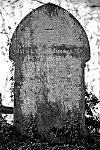
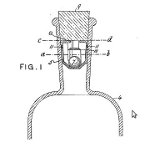 Surman
trained at King's College London and served his title here, living in
Burr Street (East
Smithfield, by St Katharine's Docks), and then did further study at
TCD while curate at St Stephen Southwark. From 1887 to his death in
1917, aged 58, of heart failure several months after an operation
[headstone right], he was Rector of
Healing, near Grimsby, with a population of 324 (to which he was
presented by a relative). However, in 1897 he enlisted as a second
lieutenant in the 9th (Militia) Battalion of the 60th King's Royal Rifle Corps (formerly the North Cork Rifles, headquartered at Mallow in that county, from 1881-1908 it was part of the KRRC), and
in 1898, in proceedings instituted by the archdeacon, he was fined a third of his stipend by Lincoln Consistory Court
because of his absence from parochial duties for 126 days in 1897, and 108 days the following year, giving musketry
instruction to volunteers. In 1899 he patented a non-refillable bottle [right]. The following
year he faced a libel action brought by Emily Raynor of Grimsby (what
was the outcome?); the same year he married Bessie Stacpoole (whose
family had lived in Mexico) at
St Matthew Bayswater. He - or she - must have had considerable means,
as in 1914 he sued his stockbrokers in the High Court for negligence in
relation to a 'bear' or
'oversold' account ('when the speculative sales exceed the speculative
purchases') which they had set up on his behalf with £10,000 Consols
stock. In 1904 a curate was licensed to take temporary charge of the
parish, perhaps because of some further exploit. A final project was a
16-page Treatise on
Ecclesiastical Dilapidations (the
amounts then payable by incumbents towards work on their
parsonages), published by Jackson & Son in 1915.
Surman
trained at King's College London and served his title here, living in
Burr Street (East
Smithfield, by St Katharine's Docks), and then did further study at
TCD while curate at St Stephen Southwark. From 1887 to his death in
1917, aged 58, of heart failure several months after an operation
[headstone right], he was Rector of
Healing, near Grimsby, with a population of 324 (to which he was
presented by a relative). However, in 1897 he enlisted as a second
lieutenant in the 9th (Militia) Battalion of the 60th King's Royal Rifle Corps (formerly the North Cork Rifles, headquartered at Mallow in that county, from 1881-1908 it was part of the KRRC), and
in 1898, in proceedings instituted by the archdeacon, he was fined a third of his stipend by Lincoln Consistory Court
because of his absence from parochial duties for 126 days in 1897, and 108 days the following year, giving musketry
instruction to volunteers. In 1899 he patented a non-refillable bottle [right]. The following
year he faced a libel action brought by Emily Raynor of Grimsby (what
was the outcome?); the same year he married Bessie Stacpoole (whose
family had lived in Mexico) at
St Matthew Bayswater. He - or she - must have had considerable means,
as in 1914 he sued his stockbrokers in the High Court for negligence in
relation to a 'bear' or
'oversold' account ('when the speculative sales exceed the speculative
purchases') which they had set up on his behalf with £10,000 Consols
stock. In 1904 a curate was licensed to take temporary charge of the
parish, perhaps because of some further exploit. A final project was a
16-page Treatise on
Ecclesiastical Dilapidations (the
amounts then payable by incumbents towards work on their
parsonages), published by Jackson & Son in 1915.| The
Church militant, in a literal sense, has a doughty champion in the
rector of Taxal, the Rev. Samuel Evans, M.A., who had a dispute with
one of his parishioners, Col. Edward Hall, [Lt-Col Hall was a local JP, non-resident but elected as the people's warden] and, being unable to prevail
by force of reasoning, struck him with a violent blow on the cheek with
his fist. All this to-do was about the annual vestry meeting. The blow
was struck in the church itself, and it frightened away the
congregation; the rector, the clerk, and the organist being left to go
through the service. At Stockport, four days later, the rev. gentleman
expressed regret for his hasty and ill-sonsidered action, whereupon he
was bound over [in the sum of £10] to keep the peace for six months. It is an odd thing
that vestry meetings are more fruitful of contentious matter and angry
denunciations than any other sort of gatherings whatsoever. |
| Per fesse nebuly argent and sable, in chief two lions rampant of the second, and in base an osprey with wings displayed proper. Mantling sable and argent. Crest —Upon a wreath of the colours, an osprey, as m the arms, resting the dexter claw on an escutcheon of the Butler arms, namely or, a chiefindented azure. |
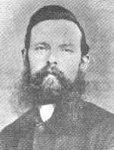 Francis
Jephcott (1890-98) [right]
shuttled between Canada and various parts of England, holding 16 posts
over the course of his ministry. A qualified medical doctor, he trained at Queen's College
Birmingham and was ordained in 1869 in the diocese of Huron, Ontario,
serving two missionary posts as a deacon, at Tilsonberg and
Cannington (where a church had been established four years earlier); he
returned to curacies in Runcorn in Cheshire (and only then was priested, at Chester Cathedral in 1872) and
from 1874 at Kirkham in
Lancashire (then in Manchester diocese). After five years as chaplain to Southwell House of
Correction (where in 1877 an inmate was charged with assaulting him), and a year as a prison chaplain in Norwich, and a further
brief stint at Halsall, near Ormskirk, in 1883 he was approved by SPG for
missionary service (as was, in the same year, William Brown Keer, above)
to serve in the diocese of Rupert's Land. He worked in Gladstone,
Manitoba - returning for a year's curacy at Holy Trinity Blackburn - and from 1887
in Burk's Falls, Ontario (where the diocese of Algoma had been carved
out of Toronto in 1872). He wrote to SPG You
have no idea what this country is like, only here and there a few acres
chopped out of the solid forest. I have often not time to eat,
distances are so great, roads so bad, churches so many to attend to. I
walk generally all over my mission. (It's estimated that over the course of a year he travelled 5,000 miles.)
Francis
Jephcott (1890-98) [right]
shuttled between Canada and various parts of England, holding 16 posts
over the course of his ministry. A qualified medical doctor, he trained at Queen's College
Birmingham and was ordained in 1869 in the diocese of Huron, Ontario,
serving two missionary posts as a deacon, at Tilsonberg and
Cannington (where a church had been established four years earlier); he
returned to curacies in Runcorn in Cheshire (and only then was priested, at Chester Cathedral in 1872) and
from 1874 at Kirkham in
Lancashire (then in Manchester diocese). After five years as chaplain to Southwell House of
Correction (where in 1877 an inmate was charged with assaulting him), and a year as a prison chaplain in Norwich, and a further
brief stint at Halsall, near Ormskirk, in 1883 he was approved by SPG for
missionary service (as was, in the same year, William Brown Keer, above)
to serve in the diocese of Rupert's Land. He worked in Gladstone,
Manitoba - returning for a year's curacy at Holy Trinity Blackburn - and from 1887
in Burk's Falls, Ontario (where the diocese of Algoma had been carved
out of Toronto in 1872). He wrote to SPG You
have no idea what this country is like, only here and there a few acres
chopped out of the solid forest. I have often not time to eat,
distances are so great, roads so bad, churches so many to attend to. I
walk generally all over my mission. (It's estimated that over the course of a year he travelled 5,000 miles.)| At
the Worship street Police-court on Wednesday, Miss Mary Baskin, of
Cornwall-road, Notting-hill, appeared to an adjourned summons, charging
her with having published a certain malicious and defamatory libel
concerning the Rev. George Horlock, curate of St. Leonard's Church,
Shoreditch, and his wife, Charlotte Horlock ... There was a
cross-summons for libel against the Rev Mr. Horlock, aud a summons had
also been granted against Miss Baskin for stealing a registered letter.
The complainant, the Rev. G. Horlock, resides at North-villa, Camden
Town, and the defendant, Miss Baskin, a dramatic reader, had lived as a
boarder at the house. The unpleasantness seemed to have arisen from the
loss of a letter, which the defendant had been accused of stealing, and
since she had left the house some unpleasant correspondence had passed.
Both parties complained of having been libelled, and it transpired that
some of the objectionable letters on which the cross-summons had been
granted had been addressed to a gentleman to whom Miss Baskin was
engaged to be married. In the letters put in and read by Mr. Wontner
(which were of very great length) a great many matters in dispute were
touched upon, Mr and Mrs. Horlock being accused of persecuting Miss
Baskin and alleging dishonesty. From all the letters read on each side,
however, it was clear that both aides had attacked one another's
character to the uttermost extreme, every detail of their past history
being dwelt upon at great length and in offensive language. Mrs.
Horlock had also joined in the correspondence, having written long
letters concerning Miss Baskin. In one of these Mrs. Horlock,
addressing the defendant, accused her of serious misbehaviour, and said
she thought the gentleman she was engaged to must be 'blinded by love'
not to see what she (the defendant) really was. This and other letters
she had sent to the gentleman. The large mass of correspondence having
been read, and the complainant and his wife cross-examined, the case
for the complainant was completed, and the evidence was read over. The
other summonses were then adjourned. |
 It was at this point that he came to St Paul's. He
went on to Holy Trinity Kilburn, and Holy Trinity
Shoreditch, where he lived at Tower House, Angela Gardens - part of 'Miss
Coutts' (Columbia) Market' - from where in 1912 he provided a
testimonial to the beneficial effects of the tonic 'Iron Jelloids', left
(2a, with quinine, was the male version of this preparation). There
were other lawsuits along the way: for example, in 1909 he gave a
position to an ex-prisoner in whom a group of female parishioners had
taken an 'interest' and who committed a fraud using one of his cheques.
It was at this point that he came to St Paul's. He
went on to Holy Trinity Kilburn, and Holy Trinity
Shoreditch, where he lived at Tower House, Angela Gardens - part of 'Miss
Coutts' (Columbia) Market' - from where in 1912 he provided a
testimonial to the beneficial effects of the tonic 'Iron Jelloids', left
(2a, with quinine, was the male version of this preparation). There
were other lawsuits along the way: for example, in 1909 he gave a
position to an ex-prisoner in whom a group of female parishioners had
taken an 'interest' and who committed a fraud using one of his cheques.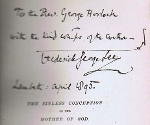 Some of these parishes where he served matched the protestant style of St
Paul's, but others were of decidedly more 'advanced' churchmanship,
particularly Holy Trinity Shoreditch, where the brother of a former Vicar of Christ
Church Watney Street was the incumbent (see here for details), and whose ritualistic practices were noted in the evidence to the Royal Commission on Ecclesiastical Discipline - as were those of Horlock himself, as an occasional celebrant at St Ethelburga Bishopsgate: on Ascension Day 1904 he wore vestments, acolyte in red cassock and lace trimmed cotta. The
celebrant appeared to go through the Confiteor, the beatings of the
breast being very noticeable. At the Incarnatus in the Nicene Creed he
knelt and crossed himself at the end of the creed. He performed the
ceremonial mixing and the Lavabo. He gave the Absolution with the sign
of the Cross. The Benedictus qui venit and Agnus Dei were added..... This was not a new development for him, for in 1895 Frederick George Lee had inscribed a copy of his essay 'The Sinless Conception of the Mother of God' to Horlock, with the kind comps of the author [right].
Some of these parishes where he served matched the protestant style of St
Paul's, but others were of decidedly more 'advanced' churchmanship,
particularly Holy Trinity Shoreditch, where the brother of a former Vicar of Christ
Church Watney Street was the incumbent (see here for details), and whose ritualistic practices were noted in the evidence to the Royal Commission on Ecclesiastical Discipline - as were those of Horlock himself, as an occasional celebrant at St Ethelburga Bishopsgate: on Ascension Day 1904 he wore vestments, acolyte in red cassock and lace trimmed cotta. The
celebrant appeared to go through the Confiteor, the beatings of the
breast being very noticeable. At the Incarnatus in the Nicene Creed he
knelt and crossed himself at the end of the creed. He performed the
ceremonial mixing and the Lavabo. He gave the Absolution with the sign
of the Cross. The Benedictus qui venit and Agnus Dei were added..... This was not a new development for him, for in 1895 Frederick George Lee had inscribed a copy of his essay 'The Sinless Conception of the Mother of God' to Horlock, with the kind comps of the author [right]. Joshua Powell Parry (1903-07)
was the Vicar's brother.
He was born in 1871 in Flint, and like other clerical members of the
family attended Liverpool Institute and studied at Jesus College
Cambridge. St Paul's was his title parish, after which he spent four
years as the first chaplain of South Perak, living in Batu Gajah, and overseeing the
building of what was then the largest church in the Malay States, St
John's Ipoh, consecrated in 1912 [right]:
it was
to have been stone-faced but they had to economise and use brick.
(During the Japanese occupation it was used as a noodle factory.) See here for details of its centenary celebrations. On
his return he held a succession of posts in various dioceses - as a
licensed preacher in Norwich, a curate in Ipswich, ten years as Vicar
of Bilsdale in Yorkshire, and one year as Vicar of St Stephen Ayres
Quay in Bishop Wearmouth, ended in 1925 by the issue of a receiving
order for bankruptcy (he had moved to Cromer, living at 'Linkside' -
now an extended residential development). Two years later he was
given permission to officiate in Fishponds, and then a curacy at
Thornbury (both in Gloucester diocese). He died in 1930, a year after
his older sister Catherine Margaret, who was an inmate of the West
Riding Mental Hospital in Clifton, and whose affairs he had looked
after.
Joshua Powell Parry (1903-07)
was the Vicar's brother.
He was born in 1871 in Flint, and like other clerical members of the
family attended Liverpool Institute and studied at Jesus College
Cambridge. St Paul's was his title parish, after which he spent four
years as the first chaplain of South Perak, living in Batu Gajah, and overseeing the
building of what was then the largest church in the Malay States, St
John's Ipoh, consecrated in 1912 [right]:
it was
to have been stone-faced but they had to economise and use brick.
(During the Japanese occupation it was used as a noodle factory.) See here for details of its centenary celebrations. On
his return he held a succession of posts in various dioceses - as a
licensed preacher in Norwich, a curate in Ipswich, ten years as Vicar
of Bilsdale in Yorkshire, and one year as Vicar of St Stephen Ayres
Quay in Bishop Wearmouth, ended in 1925 by the issue of a receiving
order for bankruptcy (he had moved to Cromer, living at 'Linkside' -
now an extended residential development). Two years later he was
given permission to officiate in Fishponds, and then a curacy at
Thornbury (both in Gloucester diocese). He died in 1930, a year after
his older sister Catherine Margaret, who was an inmate of the West
Riding Mental Hospital in Clifton, and whose affairs he had looked
after.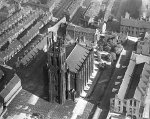 George
Alexander Dunlop (1908-13),
born c1869, was a Glasgow graduate. By 1901 (census) he was an acting army
chaplain, living in Shoeburyness with his wife Jenny and sons George
and Maxwell, and he was ordained in 1905 to St Mary Whitechapel before
coming to this parish (living at 11 Dock Street). After a year as
curate of St Andrew Undershaft in the City (the parish's income
provided the stipend for the first Bishop of Islington),
living at 8 The Crescent, Minories (now with four further children, plus a governess and a cook), he became Vicar of St Mary
Leeds in 1914, where in 1917 he was declared bankrupt (discharged in
1920 having paid his creditors 5½d in the £), but remained in post
until
the mid-1930s. In 1933 he conducted the marriage of his daughter
Dorothy to Roderick Dhu Drummond (an accountant!) His namesake son
George, born in 1900, was conscripted in 1918 while a student at Leeds University; he died at Caringbah, New South Wales in 1967.
George
Alexander Dunlop (1908-13),
born c1869, was a Glasgow graduate. By 1901 (census) he was an acting army
chaplain, living in Shoeburyness with his wife Jenny and sons George
and Maxwell, and he was ordained in 1905 to St Mary Whitechapel before
coming to this parish (living at 11 Dock Street). After a year as
curate of St Andrew Undershaft in the City (the parish's income
provided the stipend for the first Bishop of Islington),
living at 8 The Crescent, Minories (now with four further children, plus a governess and a cook), he became Vicar of St Mary
Leeds in 1914, where in 1917 he was declared bankrupt (discharged in
1920 having paid his creditors 5½d in the £), but remained in post
until
the mid-1930s. In 1933 he conducted the marriage of his daughter
Dorothy to Roderick Dhu Drummond (an accountant!) His namesake son
George, born in 1900, was conscripted in 1918 while a student at Leeds University; he died at Caringbah, New South Wales in 1967.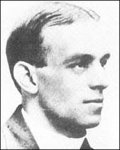 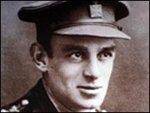 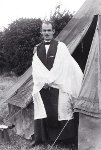 St Mary Leeds'
chief claim to fame is that Geoffrey Anketell Studdert Kennedy (1883-1929)
began his life in its sprawling vicarage (the seventh of nine children). He was a pupil at Leeds
Grammar School, deferring a scholarship to Trinity College Dublin (aged
14) but eventually graduating there in classics and divinity in 1904. After a year's
training at Ripon College, he was ordained in 1910 and served his title in Rugby
and became vicar of St Paul Worcester in 1914 (in its poorest area of Blockhouse Fields). On the outbreak of war,
he volunteered as a chaplain on the Western Front, where he became
known as 'Woodbine Willie' because he offer cigarettes as well as
spiritual consolation. He won the Military Cross on 1917 at Messines
Ridge after running into no man's land to help the wounded. His poems Rough Rhymes of a Padre (1918),
and More Rough Rhymes (1919) - some in dialect, others
expressing his deeply-held catholic sacramental theology - remain a poignant and
fascinating record of these years. Some dismissed them as sentimental,
but they made a strong impact, and together with other verses (such as Peace Rhymes of a Padre, The Sorrow of God and other poems (1921) and Songs of Faith and Doubt (1922) remained in print for some years. with a collected edition in 1929. In The Unutterable Beauty he remarked ruefully, and with painful insight, on his nickname: St Mary Leeds'
chief claim to fame is that Geoffrey Anketell Studdert Kennedy (1883-1929)
began his life in its sprawling vicarage (the seventh of nine children). He was a pupil at Leeds
Grammar School, deferring a scholarship to Trinity College Dublin (aged
14) but eventually graduating there in classics and divinity in 1904. After a year's
training at Ripon College, he was ordained in 1910 and served his title in Rugby
and became vicar of St Paul Worcester in 1914 (in its poorest area of Blockhouse Fields). On the outbreak of war,
he volunteered as a chaplain on the Western Front, where he became
known as 'Woodbine Willie' because he offer cigarettes as well as
spiritual consolation. He won the Military Cross on 1917 at Messines
Ridge after running into no man's land to help the wounded. His poems Rough Rhymes of a Padre (1918),
and More Rough Rhymes (1919) - some in dialect, others
expressing his deeply-held catholic sacramental theology - remain a poignant and
fascinating record of these years. Some dismissed them as sentimental,
but they made a strong impact, and together with other verses (such as Peace Rhymes of a Padre, The Sorrow of God and other poems (1921) and Songs of Faith and Doubt (1922) remained in print for some years. with a collected edition in 1929. In The Unutterable Beauty he remarked ruefully, and with painful insight, on his nickname:
They
gave me this name like their nature / Compacted of laughter and tears,
/ A sweet that was born of the bitter, / A joke that was torn from the
years.
Of their travail and torture, Christ's fools, / Atoning my sins with their blood, / Who grinned in their agony sharing / The glorious madness of God. Their name! Let me hear it - the symbol / Of unpaid - unpayable debt, / For the men to whom I owed God's Peace, / I put off with a cigarette.   Like other military chaplains who
came to experience the huge gulf between the church's teaching and the
life and experience of working men, he failed to settle into post-war
ministry. He was based for a time at St Edmund King & Martyr in Lombard Street, where he wrote Lies (1919); Democracy and the Dog-Collar (1921) (with chapters such as The Church Is Not a Movement but a Mob; Capitalism is Nothing But Greed, Grab, and Profit-Mongering; and So-Called Religious Education Worse than Useless); Food for the Fed Up (1921, republished in 1928 as I Believe: Sermons on the Apostles' Creed); The Wicket Gate (1923); and The Word and the Work
(1925). Though his Christian Socialist and pacifist views were
controversial, he was appointed a royal chaplain by King George V in
1920. He toured the country as a speaker for the Industrial Christian Fellowship, appearing at many
crusades in the industrial cities; but died in Liverpool [or was it Manchester?] in 1929, of chronic asthma and
overwork, aged 45. Like other military chaplains who
came to experience the huge gulf between the church's teaching and the
life and experience of working men, he failed to settle into post-war
ministry. He was based for a time at St Edmund King & Martyr in Lombard Street, where he wrote Lies (1919); Democracy and the Dog-Collar (1921) (with chapters such as The Church Is Not a Movement but a Mob; Capitalism is Nothing But Greed, Grab, and Profit-Mongering; and So-Called Religious Education Worse than Useless); Food for the Fed Up (1921, republished in 1928 as I Believe: Sermons on the Apostles' Creed); The Wicket Gate (1923); and The Word and the Work
(1925). Though his Christian Socialist and pacifist views were
controversial, he was appointed a royal chaplain by King George V in
1920. He toured the country as a speaker for the Industrial Christian Fellowship, appearing at many
crusades in the industrial cities; but died in Liverpool [or was it Manchester?] in 1929, of chronic asthma and
overwork, aged 45. 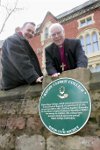 Many
wanted him to be buried at Westminster Abbey, but the Dean refused
permission, regarding him as common and uncouth. Worcester, which (as
his wife Emma stressed) he loved, proved a more fitting site. At his burial
2,000 people lined the streets, some throwing Woodbine packets onto his
cortège. A plaque in the cathedral, where he used to preach to the
troops from nearby Norton Barracks - right - marks his death, and the Social
Services building in Spring Gardens is named in his memory. There
is also a plaque - right - in Ripon (site of the former clergy college),
dedicated in 2013 by John Packer, former bishop of Ripon and Leeds. Many
wanted him to be buried at Westminster Abbey, but the Dean refused
permission, regarding him as common and uncouth. Worcester, which (as
his wife Emma stressed) he loved, proved a more fitting site. At his burial
2,000 people lined the streets, some throwing Woodbine packets onto his
cortège. A plaque in the cathedral, where he used to preach to the
troops from nearby Norton Barracks - right - marks his death, and the Social
Services building in Spring Gardens is named in his memory. There
is also a plaque - right - in Ripon (site of the former clergy college),
dedicated in 2013 by John Packer, former bishop of Ripon and Leeds. The most recent
of a number of biographies, drawing on others' work (eg J.K. Mosley (ed) G.A. Studdert Kennedy - By his friends (1929); W.E. Purcell (1962), W Grundy, Woodbine Willie: An Anglican IncidentA Fiery Glow in the Darkness: Woodbine Willie, Padre and Priest (1997). Stephen Louden Chaplains in Conflict (1996), Joanna Bourke An Intimate History of Killing (2009), Edward Madigan Faith Under Fire: Anglican Chaplsins and the Great War (2011), and Michael Snape & Edward Madigan The Clergy in Khaki (2013) - is by the 'good man
of Glasgow', Bob Holman, a Christian academic who has committed himself
to living alongside the disadvantaged on the Easterhouse estate in that city: Woodbine Willie: an Unsung Hero of World War One (Lion 2013). Studdert Kennedy
is commemorated in the Anglican calendar (and also that of the American
Episcopal Church) on 8 March. We will hopefully hear more about this
emblematic character in the centenary commemorations of the First World
War. See a sermon about him here.
The most recent
of a number of biographies, drawing on others' work (eg J.K. Mosley (ed) G.A. Studdert Kennedy - By his friends (1929); W.E. Purcell (1962), W Grundy, Woodbine Willie: An Anglican IncidentA Fiery Glow in the Darkness: Woodbine Willie, Padre and Priest (1997). Stephen Louden Chaplains in Conflict (1996), Joanna Bourke An Intimate History of Killing (2009), Edward Madigan Faith Under Fire: Anglican Chaplsins and the Great War (2011), and Michael Snape & Edward Madigan The Clergy in Khaki (2013) - is by the 'good man
of Glasgow', Bob Holman, a Christian academic who has committed himself
to living alongside the disadvantaged on the Easterhouse estate in that city: Woodbine Willie: an Unsung Hero of World War One (Lion 2013). Studdert Kennedy
is commemorated in the Anglican calendar (and also that of the American
Episcopal Church) on 8 March. We will hopefully hear more about this
emblematic character in the centenary commemorations of the First World
War. See a sermon about him here. |
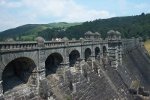
 John Evans Hughes (1913-??)
- born at Llanddewi Brefi around 1877, he was a boarder at Ystrad
Meurig Grammar School, and after St John's College Cambridge was
ordained in 1908 in St Asaph
diocese, with curacies
in Newtown (Montgomeryshire, now Powys) and Hawarden (Flintshire),
marrying Elizabeth (Bessie) Price Davies, from his home town, in 1910,
before coming here. How long he stayed in
unclear - he was living in West Kensington by 1919, when he was
appointed to the
Crown living of Dolfor, in Montgomeryshire, moving to further
incumbenices in
1922 at Holt and 1927 at Llanwddyn, near Oswestry (where in the 1880s
the original village [right] had been flooded for the creation of Lake Vyrnwy to supply water to Liverpool). He died around 1948, aged 71.
John Evans Hughes (1913-??)
- born at Llanddewi Brefi around 1877, he was a boarder at Ystrad
Meurig Grammar School, and after St John's College Cambridge was
ordained in 1908 in St Asaph
diocese, with curacies
in Newtown (Montgomeryshire, now Powys) and Hawarden (Flintshire),
marrying Elizabeth (Bessie) Price Davies, from his home town, in 1910,
before coming here. How long he stayed in
unclear - he was living in West Kensington by 1919, when he was
appointed to the
Crown living of Dolfor, in Montgomeryshire, moving to further
incumbenices in
1922 at Holt and 1927 at Llanwddyn, near Oswestry (where in the 1880s
the original village [right] had been flooded for the creation of Lake Vyrnwy to supply water to Liverpool). He died around 1948, aged 71.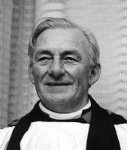
 Gordon Budd [left, and with his wife in 1962], born 1908, served
his title here from 1953-55, having trained at Lincoln Theological
College after many years in the Navy. He and his wife lived in poor
accommodation in Chamber Street. They ran a successful youth club; he
was very practical (especially with electrical items) and she was the
sacristan. After a second curacy in Stoke Newington he became Rector of
Bacton with Wyverstone, near Stowmarket, in 1958, and in 1961 moved to
Scotland: to Holy Trinity Stirling, then in 1974 to St Ninian Aberdeen
(a struggling estate church, now attached to the Cathedral), and in 1976 to Dufftown, where he died in 1988.
Gordon Budd [left, and with his wife in 1962], born 1908, served
his title here from 1953-55, having trained at Lincoln Theological
College after many years in the Navy. He and his wife lived in poor
accommodation in Chamber Street. They ran a successful youth club; he
was very practical (especially with electrical items) and she was the
sacristan. After a second curacy in Stoke Newington he became Rector of
Bacton with Wyverstone, near Stowmarket, in 1958, and in 1961 moved to
Scotland: to Holy Trinity Stirling, then in 1974 to St Ninian Aberdeen
(a struggling estate church, now attached to the Cathedral), and in 1976 to Dufftown, where he died in 1988.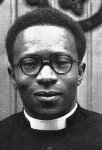 Samuel Hugh
Stowell Akinsope (Sammy or Sope) Johnson (1955-58) [right] - a Nigerian whose middle names are those of a famous 19th century Evangelical preacher
and church planter from Salford! - who had trained at Lichfield
Theological College, and served his title here, living on the top floor
of the vicarage; he was popular as a visitor,
with local folk as much as with incomers,
and
played cricket and football with the boys and adults of the
parish. Three
further curacies, at Sunbury, Maida Hill and St Martin-in-the-Fields
(which had sponsored him) followed while he studied theology at London
University (St Paul's
gave his hood when he graduated in 1961). He then returned to
Nigeria, later becoming the national head of religious broadcasting,
and was Provost
of Christ Church
Cathedral, Lagos from 1970 to his retirement in 1995. In 1975 he was
involved in a conflict with the bishop (his predecessor as provost)
over the introduction of contemporary forms of worship, and was briefly
suspended; this
report give a full account (some of the terminology is inaccurate). His
is the fourth generation of the family to be involved in ministry in
Nigeria; see this article, by his son (then an archdeacon, and from 2009 the next-but-one Provost after his father) on the slave trade.
Samuel Hugh
Stowell Akinsope (Sammy or Sope) Johnson (1955-58) [right] - a Nigerian whose middle names are those of a famous 19th century Evangelical preacher
and church planter from Salford! - who had trained at Lichfield
Theological College, and served his title here, living on the top floor
of the vicarage; he was popular as a visitor,
with local folk as much as with incomers,
and
played cricket and football with the boys and adults of the
parish. Three
further curacies, at Sunbury, Maida Hill and St Martin-in-the-Fields
(which had sponsored him) followed while he studied theology at London
University (St Paul's
gave his hood when he graduated in 1961). He then returned to
Nigeria, later becoming the national head of religious broadcasting,
and was Provost
of Christ Church
Cathedral, Lagos from 1970 to his retirement in 1995. In 1975 he was
involved in a conflict with the bishop (his predecessor as provost)
over the introduction of contemporary forms of worship, and was briefly
suspended; this
report give a full account (some of the terminology is inaccurate). His
is the fourth generation of the family to be involved in ministry in
Nigeria; see this article, by his son (then an archdeacon, and from 2009 the next-but-one Provost after his father) on the slave trade.
See here for the period after the merger with St George-in-the-East when Joseph Thomas Davies was curate-in-charge.